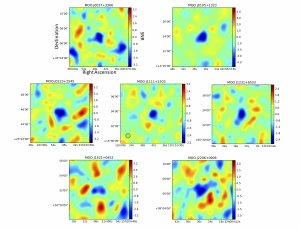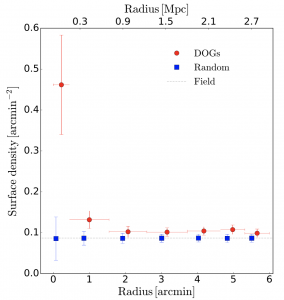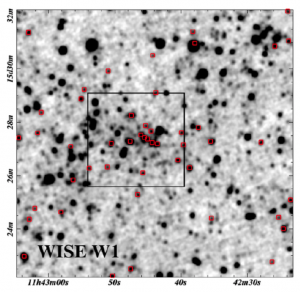Current Research Interests
Massive Clusters Over Cosmological Time (Brodwin)
My work involves the observational discovery and study of massive, rare galaxy clusters. I'm interested in these most massive collapsed systems both as unique astrophysical objects, which permit the study of galaxy formation and evolution in extreme environments, and as cosmological probes of the growth of large scale structure. We study the properties of clusters and their galaxy populations using the largest facilities on Earth (Keck, Gemini, Magellan, JVLA, SPT, CARMA) and in space (Hubble, Spitzer, Chandra, Herschel, WISE, Planck) spanning the entire elecromagnetic spectrum.
Current projects include clusters selected primarily at infrared wavelengths — the IRAC Shallow Cluster Survey (ISCS), the IRAC Distant Cluster Survey (IDCS), and the Massive and Distant Cluster of Wise Survey (MaDCoWS) — and millimeter wavelengths using the Sunyaev-Zel'dovich (SZ) effect. These include the first generation South Pole Telescope (SPT) SZ survey, the ongoing polarization-sensitive SZ survey (SPTpol), and the upcoming, extremely sensitive SPT-3G survey currently being deployed at the South Pole. Dr. Brodwin is also a full member of the Euclid Consortium, which is currently preparing a major optical/IR space telescope for launch in 2020 to study the nature of dark energy.
The cluster at right, IDCS J1426.5+3508, has a mass of over 400 trillion Suns and is located 10 billion light years away (z=1.75). It is the most massive cluster yet discovered at a time when the Universe was less than a third of its current age. See the Press section for an overview and my Publications for more details.

Massive and Distant Clusters of WISE Survey (MaDCoWS): Stellar Mass Fraction in IR-selected Galaxy Clusters at z ~ 1 (Ph.D. Student: Bandon Decker)
The Massive and Distant Clusters of WISE Survey (MaDCoWS; Gonzalez et al., 2019) is a high-redshift (z~1) survey that selects galaxy clusters in the infrared over nearly the full extragalactic sky using the Wide-field Infrared Survey Explorer (WISE) AllWISE data release. We have measured Sunyaev-Zel'dovich (SZ) masses for twelve MaDCoWS clusters spectroscopically confirmed to lie in the range 0.9 < z <1.3 using the Combined Array for Research in Millimeter-wave Astronomy (CARMA). This sample includes several of the most massive clusters yet found at z>1. Using follow-up Spitzer/IRAC rest-frame near-infrared observations, we have measured the stellar mass of a dozen of these clusters.
My work has focussed on comparing the stellar mass <it>fraction</it> of these dozen infrared-selected clusters to a sample of ~30 ICM-selected clusters in the same redshift range from the South Pole Telescope (SPT)-SZ survey. In my paper, Decker et al., (2019) I find that the mean stellar mass fraction of the MaDCoWS clusters is only higher than the mean for the SPT sample by 1.0 sigma and even this difference may be driven by the MaDCoWS sample having a larger fraction of merging cluster than the SPT sample.
The image below shows the CARMA 30 GHz maps of seven of the clusters first presented in Decker et al., (2019), including MOO J1521+0452 which is one of the most massive clusters yet found by any means at z > 1.3.

Herschel Obscured Galaxies as Signposts of High Redshift Clusters (Ph.D. Student: Ripon Saha)
Identifying high redshift clusters at optical and X-ray wavelengths is challenging due to cosmological K-correction and surface brightness dimming effects, respectively. Rest-frame near-infrared cluster searches, such as the IRAC Shallow/Distant Cluster Surveys (ISCS/IDCS; Eisenhardt et al. 2008, Brodwin et al. 2011, Stanford et al. 2012, Zeimann et al. 2013), have provided the first statistical samples at z>1.3. Study of those clusters has revealed significant star formation activity (Brodwin et al. 2013, Alberts et al. 2014, 2016).
We are currently exploiting this correlation between distant clusters and high star formation activity to identify clusters at the highest redshifts. We begin with the 2600 Dust-Obscured galaxies (DOGs; detected using 24 um Spitzer MIPS data) -- ULIRGs with high star formation rates --- in the 9 square degree Bootes field in the Spitzer Deep, Wide-Field Survey (SDWFS). We find evidence that these DOGs have a strong spatial correlation with independently selected high redshift clusters. This result indicates that DOGs aren't randomly distributed, rather they preferentially reside in rich environments, often within ∼250 kpc of a galaxy cluster. Demonstration of this physical association has motivated a new approach to the discovery of high redshift clusters. Specifically, we compute and rank the overdensities of high redshift SDWFS galaxies about these DOGs to identify new candidate z > 1.3 clusters. Our analysis is being written up for publication in the Astrophysical Journal.
The plot at right shows the surface number density of DOGs around the ISCS galaxy clusters (z > 1.3) in radial slices. The dotted horizontal line represents the mean surface density of DOGs across the sky in Bootes. Blue rectangles represent the surface density of the randomly distributed objects around the same cluster sample. The horizontal bars represent the radial bin sizes. The vertical error bars depict the 68% confidence intervals. Circular symbols are shown with slight offset for clarity. We find that the sky surface density of DOGs within a ~0.5 arcmin radius around the z > 1.3 ISCS galaxy clusters in Bootes is 0.46 ± 0.12 arcmin^-2. The detection is overdense by a factor of 5.3 ± 1.4 relative to the surface density of randomly distributed objects, corresponding to a detection significance of ∼ 3σ.

Dependence of AGN Activity on Halo Mass and Redshift in the SPT- SZ Cluster Survey (Ph.D. Student: Benjamin Floyd)
Recent studies have shown that the incidence of AGN in galaxy clusters rises with lookback time by nearly two orders of magnitude from the local Universe to z~1.5 (e.g. Martini et al. 2014). This increase is even faster than that occurring in field galaxies, suggesting an environment-dependent process is involved. Previous work by Dr. Brodwin and collaborators has indicated that a key mechanism driving this evolution is galaxy mergers within the cluster (Brodwin et al. 2013 and references therein). As the galaxies merge they trigger high star formation rates as well as AGN activity. As the AGN heat up and expel the gas, quenching the star formation is and leading to the observed spheroidal “red and dead” galaxies we see in clusters today. If this evolutionary mechanism is correct, the AGN activity in clusters should decrease as the mass of the cluster grows large enough for merging of galaxies to become inefficient. Ehlert et al. (2015) independently found that the incidence of X-ray AGN scales inversely with cluster mass for low redshift clusters. My project is to perform a similar analysis using infrared (IR) selected AGN in the Sunyaev—Zel’dovich (SZ)-selected galaxy clusters at z~1 from the South Pole Telescope (SPT) survey. The plot at right shows the rapid increase in the AGN fraction with redshift, from Martini et al. (2014). The points at z > 1 are from the infrared-selected IRAC Shallow Cluster Survey (ISCS).

Incidence of X-Ray Bright AGN in z~1 MaDCoWS Clusters (MS Student: Mustafa Muhibullah)

Finding High-Redshift Lyman-Break Galaxies Lensed by z~1 Galaxy Clusters (UG Student: Katie Denny)
As light from distant galaxies propagates through the Universe, wavelengths blueward of (redshifted) 912 Angstroms are absorbed by the intervening intergalactic hydrogen producing a sharp continuum break. For high redshift galaxies, light travels such a distance that this Lyman break shifts into the optical. This causes the objects to disappear in the bluest filter while still remaining prominent in redder ones. We can use the Lyman-Break technique to find high-redshift galaxies (z ≳ 3.5) lensed by z~1 galaxy clusters. Finding these objects lensed by galaxy clusters can allow us to study the properties of high redshift objects, map out the dark matter concentrations of clusters, and build up statistics on the presence of gravitational arcs. Using the MaDCoWS survey, we are currently analyzing a sample of potential Lyman-Break galaxies with photometry given by the optical Legacy Survey. We are using the opticalg, r, and z bands to analyze color-color plots as well as infrared IRAC images for broader SED information. Future work may include studies of lensed BzK galaxies, a selection that includes the passive population of high redshift galaxies.
Photometric Redshifts to Determine Galaxy Membership in MaDCoWS clusters (UG Student: Jerrah Biggerstaff)
The Massive and Distant Clusters of Wise Survey (MaDCoWS) is the only all sky survey designed to detect the most massive galaxy clusters in the Universe at z ~ 1. Follow-up observations with the Spitzer Space Telescope were obtained for the 2000 most strongly-detected clusters. I downloaded optical images for these MaDCoWS clusters in the g, r, and z bands though the NOAO Database. I then ran photometry on Spitzer-detected sources using IRAF for each image, combining the fluxes with existing IRAC Channel 1 and 2 data in order to create a five band catalog. We are currently in the process of running photometric redshift code on these new catalogs in hopes of determining photo z’s and therefore cluster membership. With this information we can then measure luminosity functions and/or stellar mass functions for the clusters as a function of cluster richness.

